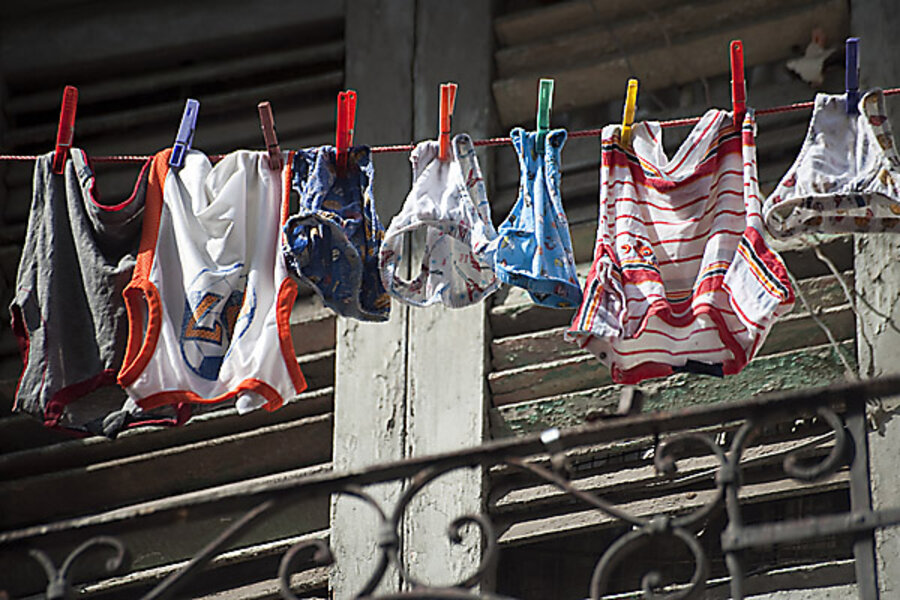How much do you really save by air-drying your clothes?
Loading...
When I was growing up, my mother always hung clothes out to dry, sometimes even in the winter. Where I currently live, there’s not really a place to install a clothesline that would catch any wind at all (I could put one at the edge of our property where it would catch a little wind, but this would really disrupt the open area our children use to play). A clothesline is one thing I definitely wish to have when we eventually move to the country.
So I sometimes use an alternative solution. I simply hang up a clothesline from our laundry room over to the guest bedroom, taking up part of the hallway in our basement. On that line, I can hang quite a few clothes without a problem. It takes most of a day to air dry them – this is aided on windy days when I can open all of the windows and doors in the basement to help the process.
Given the time that this takes compared to just tossing the clothes into the dryer, is it really worth my time? Let’s run the numbers a bit to find out.
The “Saving Electricity” website reports that the average dryer uses 3.3 kilowatt hours of energy and estimates an average of 11 cents per kilowatt hour. A small load of clothes takes about 45 minutes in the dryer, so the cost of that load is $0.36.
When I hang up my own line, I can hang up about three small loads of clothes at once on it. This is on average – I can do a bit more if it’s mostly my clothes and a bit less if it’s mostly kid’s clothes, but the three loads per line is a good calculation. That means that filling up the line and letting it air dry saves about $1.08.
Is it worth it? The real question comes from how long it takes me to do it. I can string up the line in about fifteen seconds, and I can hang a load’s worth of clothes in about two minutes or so – it’s really not that hard. I probably spend another fifteen seconds opening up doors and windows to maximize air drying, so the total extra time investment for that $1.08 is about six and a half minutes.
This means that if I repeated this exercise about nine times, I’d end up devoting about an hour to hanging up laundry and I’d save $9.96. As always, that’s $10 an hour after taxes – you don’t have to take income tax out of those “earnings.”
There are a couple other factors worth considering here.
Dryer sheets
If you’re hanging up the clothes, you’re not using dryer sheets. I usually use a quarter cup of vinegar in the rinse cycle as our laundry softener, so this isn’t really a concern for us, but if you use dryer sheets, you’ll either be abandoning them (a savings) or switching to something else. I encourage you to try vinegar – it seems to soften really well and doesn’t add any smell to the clothes.
The environment
Anything that cuts down on home energy use is a good thing and dryers certainly suck down the juice. Of course, if you’re opening windows for the purpose of air flow, you might also be doing this to help you keep the air conditioning off, which is another big environmental (and financial) boon. We try to resist using our air conditioner except during the day on particularly hot days, so opening the windows here is a natural thing to encourage air flow.
To put it simply, hanging up laundry is a decent but not world-beating saver. It’s worth doing particularly if you have environmental concerns for doing so, but other factors can easily trump it (like air conditioning, for instance). I, for one, like the smell of air-dried clothes quite a lot and it’s a good, repetitive activity that lets my mind wander in creative directions while doing it, so I think I’ll continue to hang laundry on a fairly regular basis.
Add/view comments on this post.
------------------------------
The Christian Science Monitor has assembled a diverse group of the best economy-related bloggers out there. Our guest bloggers are not employed or directed by the Monitor and the views expressed are the bloggers' own, as is responsibility for the content of their blogs. To contact us about a blogger, click here. To add or view a comment on a guest blog, please go to the blogger's own site by clicking on the link above.





